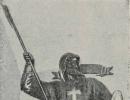Complex drawing of monge basic concepts. Complex drawing of a monge. Methods of rectangular projection on two and three
INTRODUCTION........................................................ ........................................................ ....4
1 METHODOLOGICAL INSTRUCTIONS FOR SOLVING PROBLEMS...................................4
2 ACCEPTED NOTATIONS.................................................... ...................5
3 TOPIC 1 COMPLEX DRAWING OF MONGE (point, straight line) ....... 6
3.1 Complex drawing of a point. ....... .......................................... ...................6
Exercises. ........................................................ ........................................................ ..6
Tasks. ........................................................ ........................................................ ............7
Examples of problem solving………………………………………………………..8
Knowledge self-control tests………………………………………………………………10
3.2 Complex straight line drawing.................................................... ....................eleven
Exercises. ........................................................ ........................................................ .eleven
Tasks. ........................................................ ........................................................ ...........12
Examples of problem solving………………………………………………………..13
Knowledge self-tests……………………………...................................15
4 TOPIC 2 COMPLEX DRAWING OF MONGE (PLANE).......17 PERPENDICULARITY OF STRAIGHTS AND PLANES
4.1 Complex plane drawing.................................................... ...............17
Exercises. ………………….................................. ....................................17
Tasks. ….................................................. ........................................................ ........19
Examples of problem solving……………………………………………………………......21
Knowledge self-tests………………………………………………………......21
4.2 Perpendicularity of straight lines and planes....................................................23
Exercises. ........................................................ ........................................................ .23
Tasks. ….................................................. ........................................................ .......24
Examples of problem solving……………………………………………………………......25
Knowledge self-tests……………………………………………………......................26
5 TOPIC 3 Mutual position of straight lines and planes
Exercises. ........................................................ ........................................................ .27
Tasks. ........................................................ ........................................................ ..........29
Examples of problem solving. ........................................................ ...............................thirty
Knowledge self-control tests……………………………………………………......................31
6 TOPIC 4 METHODS OF CONVERTING A DRAWING....................................33
Exercises. ........................................................ ........................................................ .33
Tasks................................................. ........................................................ ............34
Examples of problem solving. ........................................................ ...............................36
Knowledge self-tests……………………………………………………......38
7 TOPIC 5 POLYHEDAL SURFACES...............................................40
Exercises. ........................................................ ........................................................ .40
Tasks. ........................................................ ........................................................ ..........41
Examples of problem solving. ........................................................ ...............................43
Knowledge self-control tests................................................................... ........................44
BIBLIOGRAPHICAL LIST………………...................................47
APPLICATION.................................................................................................47
INTRODUCTION
Tutorial intended for laboratory classes in descriptive geometry for students of the Faculty of Land Management and Forestry (directions: 250700 - landscape architecture, 250100 - Forestry).
The manual is used by students when self-training for the next lesson. To do this he must:
Study theoretical material on a given topic and answer self-control questions;
Complete exercises on a given topic.
At the beginning of the lesson, the teacher checks the students’ theoretical preparation and solutions to exercises on a given topic. At the end of each topic, examples of solving typical problems. Getting started with the exercises new topic, it is useful to familiarize yourself with the corresponding example and follow it in the design of the drawing.
The manual can also be used by students for self-monitoring of acquired knowledge using tests given in the manual after examples of solving typical problems. To do this he must:
After each lesson, answer self-tests of knowledge, and use the answers given in the application of the manual to check the correctness of your knowledge.
In the process of working with the manual, students learn practical techniques used in solving problems, which allows them to develop the skills and abilities to solve them independently. As this experience accumulates, students begin to think independently at a professional level, while developing spatial and logical thinking.
METHODOLOGICAL INSTRUCTIONS FOR SOLUTION AND
FORMULATION OF TASKS
When solving problems, you must be guided by the following recommendations:
1. According to these projections geometric shapes, constituting the initial data of the problem, present their form and mutual arrangement in space both in relation to each other and relative to projection planes.
2. Outline a “spatial” plan for solving the problem. At this stage of the solution, you should refer to theorems from the course of elementary geometry, sections “Planimetry” and “Stereometry,” as well as to theoretical material in textbooks and lectures.
3. Determine the algorithm for solving the problem, briefly write down the sequence of graphical constructions, using the accepted notation.
4. Proceed with geometric constructions.
When solving a problem graphically, the accuracy of the answer depends not only on choosing the correct way to solve it, but also on the accuracy of execution geometric constructions. Therefore, when solving a problem, it is necessary to use drawing tools. Problems must be solved in a separate notebook in a cage for laboratory classes. The type and thickness of the lines are made in accordance with GOST 2.303-68 ESKD. Constructions are made in pencil. To make it easier to read the drawing resulting from the solution process, it is advisable to use colored pencils: specified elements are outlined in black, auxiliary constructions are outlined in blue, and the required elements are outlined in red. The same goal is pursued by the mandatory designation of all points and lines. In this case, the designation should be made in the process of solving the problem immediately after drawing a line or determining the point of intersection of the lines. Inscriptions and letter designations should be done in a standard font in accordance with GOST 2.304-84 ESKD.
A notebook with solved problems is presented to the teacher at the test or exam.
ACCEPTED NOTATIONS
A, B, C, D,…or 1, 2, 3, 4, … - point designation; capital letters of the Latin alphabet or Arabic numerals.
o – image of a point (the area where the point is located); a circle with a diameter of 2-3 mm using a thin line by hand.
a, b, c, d,... - line in space; lowercase letters of the Latin alphabet.
Γ, Σ, Δ,… - planes, surfaces; capital letters of the Greek alphabet.
α, β, γ, δ, ... - angles; lowercase letters of the Greek alphabet.
P - projection plane (picture plane); capital letter (pi) of the Greek alphabet.
AB– a straight line passing through points A And IN .
[AB]– a segment bounded by points A And IN .
[AB ) – ray limited by a point A and passing through a point IN.
/AB /–natural size of the segment[ AB] (equal to the original).
/Aa /–distance from point A to the line A.
/AΣ /–distance from point A to plane Σ .
/ab /–distance between lines A And b.
/GD/ - distance between surfaces G and D.
≡- coincidence (A≡B – points A and B coincide).
║ - parallel.
^ - perpendicular.
∩ - intersection.
О - belongs to, is an element of the set.
РАВС – angle with vertex at point B.
The depiction of signs must be carried out in accordance with accepted standards for the design of technical and scientific documentation.
TOPIC 1 COMPLEX DRAWING OF MONGE
(POINT, STRAIGHT)
Self-control issues
1. What is the projection of a point?
2. What is called the axis of projections? What straight lines are called “connection lines” and how are they located relative to the projection axis?
3. Is it possible to restore the position of a point in space from its projections?
4. How can you define a straight line in a complex drawing?
5. What lines are called general lines? Name the particular lines.
INTRODUCTION
Descriptive geometry studies methods for constructing flat images of spatial geometric objects, their geometric properties and methods for solving spatial geometric problems on these images, which is necessary for future specialists when using drawings in their production activities.
The guidelines are intended for students to independently prepare for laboratory classes in descriptive geometry.
The tasks discussed in the manual are grouped by topic and are used by students when independently preparing for their next lesson. To do this they must:
Decide tasks previous topic;
Study theoretical material on a given topic and answer self-control questions;
Execute exercises on a given topic;
Part tasks on the topic are solved in laboratory classes with the help of a teacher, and some are assigned for home solution.
At the beginning of the lesson, the teacher checks the students’ independently solved problems of the previous topic, the theoretical preparation of students and the solution of exercises on a given topic. At the end of each topic it is discussed example solution typical task with step-by-step execution of drawings. When starting to solve exercises on a new topic, it is useful to familiarize yourself with the corresponding example and follow it in the design of the drawing. At the end of each topic there are additional tasks. Correct solution of additional problems by students gives them the opportunity to take part in the Descriptive Geometry Olympiad, which is held at the end of the semester to identify strong students in the course. The appendix of the manual contains tests on topics for self-testing of knowledge and studied material.
In the process of working with the manual, students learn practical techniques used in solving problems, which allows them to develop the skills and abilities to solve them independently. As this experience accumulates, the student begins to think independently at a professional level.
METHODOLOGICAL INSTRUCTIONS FOR SOLUTION AND
FORMULATION OF TASKS
When solving problems, you must be guided by the following recommendations:
1. Based on the given projections of geometric figures that make up the initial data of the problem, imagine their shape and relative location in space both in relation to each other and relative to the projection planes.
2. Outline a “spatial” plan for solving the problem and establish the sequence of geometric operations with the help of which the answer to the problem can be obtained. At this stage of solving the problem, you should refer to theorems from the course of elementary geometry, sections “Planimetry” and “Stereometry,” as well as to theoretical material in textbooks and lectures.
3. Determine the algorithm for solving the problem, briefly write down the sequence of graphical constructions, using accepted notations and terminology.
4. Proceed to geometric constructions using the invariant properties of parallel projection. When fulfilling the first two points, it is also useful to establish the possible number of solutions and identify the reasons on which they depend.
5. It should be borne in mind that when carrying out geometric constructions, at any stage of solving the problem it is possible to control the correctness of their implementation. This is especially valuable considering that the problem books on descriptive geometry do not contain answers. The control is based on the invariant properties of parallel projection and theorems from school course stereometry.
When solving a problem graphically, the accuracy of the answer depends not only on choosing the correct way to solve it, but also on the accuracy of the geometric constructions. Therefore, when solving a problem, it is necessary to use drawing tools. Problems must be solved in a separate notebook in a cage for laboratory classes. The type and thickness of the lines are made in accordance with GOST 2.303-68 ESKD. Constructions are made in pencil. To make it easier to read the drawing resulting from the solution process, it is advisable to use colored pencils: specified elements are outlined in black, auxiliary constructions are outlined in blue, and the required elements are outlined in red. The same goal is pursued by the mandatory designation of all points and lines. In this case, the designation should be made in the process of solving the problem immediately after drawing a line or determining the point of intersection of the lines. Inscriptions and letter designations should be done in a standard font in accordance with GOST 2.304-84 ESKD.
A notebook with solved problems is presented to the teacher during the exam.
ACCEPTED NOTATIONS
A, B, C, D,…or 1, 2, 3, 4, … - point designation; capital letters of the Latin alphabet or Arabic numerals.
o – image of a point (the area where the point is located); a circle with a diameter of 2-3 mm using a thin line by hand.
a, b, c, d,... - line in space; lowercase letters of the Latin alphabet.
Γ, Σ, Δ,… - planes, surfaces; capital letters of the Greek alphabet.
α, β, γ, δ, ... - angles; lowercase letters of the Greek alphabet.
P - projection plane (picture plane); capital letter (pi) of the Greek alphabet.
AB– a straight line passing through points A And IN .
[AB]– a segment bounded by points A And IN .
[AB ) – ray limited by a point A and passing through a point IN.
/AB /–natural size of the segment[ AB] (equal to the original).
/Aa /–distance from point A to the line A.
/AΣ /–distance from point A to plane Σ .
/ab /–distance between lines A And b.
/GD/ - distance between surfaces G and D.
≡- coincidence (A≡B – points A and B coincide).
║ - parallel.
^ - perpendicular.
∩ - intersection.
О - belongs to, is an element of the set.
^ - angle, for example a^b - the angle between straight lines a and b.
Ð α - angle α (or number in degrees).
РАВС – angle with vertex at point B.
The depiction of signs must be carried out in accordance with accepted standards for the design of technical and scientific documentation.
TOPIC 1 COMPLEX DRAWING OF MONGE
(point, straight )
Self-control issues
1. Properties of orthogonal projection.
2. What elements are included in the projection apparatus?
3. What is called the axis of projections?
4. What is the projection of a point?
5. What straight lines are called “connection lines” and how are they located relative to the projection axis?
6. Is it possible to restore the position of a point in space from its projections?
7. How can you define a straight line in a complex drawing?
8. What lines are called general and partial lines? Construct a complex drawing.
9. How are two lines located in space relative to each other?
10. What is called the trace of a straight line?
3.1 Complex point drawing
Exercises
3.1.5. Which of the points A, B or C given in the drawing belongs to the plane P 1?
3.1.6 On a visual drawing (Figure 3.1), construct projections of A 2, B 1, C 1 and D 2 points - A, B, C and D. Determine in which quarters these points lie?

Figure 3.1
Tasks
3.2 Complex straight line drawing
Exercises
Tasks
3.2.6 Construct on a complex drawing two segments of intersecting, parallel, intersecting and competing lines, respectively.
3.2.7 Through point A(25, 30, 10) draw a segment AB parallel to the projection plane P 2 with a length of 30 mm at an angle of 45° to P 1. Write down the coordinates of point B. How many solutions does the problem have?
3.2.8 Find the natural size of the segment AB and the angles of its inclination to the planes P 1, P 2. The coordinates of the points of the segment are A (60, 5, 10), B (10, 20,40).
Examples of problem solving:
Problem 1 Which one given points A, B, C belong to plane P 1 ?
Solution. If a point lies in the P 1 plane, then its height is zero. Therefore, among the given points you need to look for a point with a height equal to zero. The height of a point is measured by the distance either from the frontal projection of the point to the axis X 1 2, or from the profile projection to the axis U 3. And if the height of the point is zero, then these projections of the point will lie on the X 12 and Y 3 axes. This condition is satisfied by the point A, whose projection A 2 lies on the axis X 12, and the projection A 3- on the axis U 3. This means that point A is located in the horizontal plane of projections P 1.
Dot WITH also lies in the projection plane. This is evidenced by the location of its projections C 1 And C 3 respectively on the axes X 12 And Z 23. This means that at the point WITH depth is zero. Therefore, it lies in the frontal plane of projections P 2.
Point B does not lie in any of the projection planes. It is located in space.
Related information.
The projection of a geometric object onto one plane, which we considered earlier, does not give a complete and unambiguous idea of the shape of the geometric object. Therefore, consider projection onto at least two mutually perpendicular planes (Fig. 1.2), one of which is located horizontally and the other vertically.
Despite the clarity, the drawing shown in Fig. 1.2 is inconvenient to work with, because the horizontal plane on it is shown with distortion. It is more convenient to carry out various constructions in a drawing, where the projection planes are located in the same plane, namely, the drawing plane. To do this, you need to rotate the horizontal plane around the OX axis by 90° and align it with the front one so that the front half of the horizontal plane goes down and the back goes up. This method was proposed by G. Monge.
Rice. 1.2. Construction of the Monge diagram:
a) spatial picture of the location of the projections of point A; b) a planar picture of the location of the projections of point A.
Therefore, the drawing obtained in this way (Fig. 1.2, b) is called a Monge diagram or a complex drawing.
Usually two projections are not enough to get a complete picture of the geometric object in question. Therefore, it is proposed to introduce a third projection plane, orthogonal to the first two (Fig. 1. 3, a).
Rice. 1.3. Construction of a three-picture complex drawing (Monge diagram):
a) spatial model of projection planes; b) three-picture complex drawing.
Then the plane P 1 called the horizontal projection plane, P 2- frontal plane of projections (since it is located in front of us along the front), P 3- profile projection plane (located in profile relative to the observer). Respectively A 1- horizontal projection of a point A, A 2- frontal projection of the point A, A 3- profile projection of a point A.
Axles OX, OY, OZ are called projection axes. They are similar to the coordinate axes of the Cartesian coordinate system with the only difference that the axis OH has a positive direction not to the right, but to the left. Now, in order to obtain projections in one plane (the drawing plane), it is necessary to expand the profile plane of the projections until it aligns with the front one. To do this, it needs to be rotated 90° around its axis OZ, and turn the front half of the plane to the right, and the back half to the left. As a result, we obtain a three-picture complex drawing (Monge diagram), shown in Fig. 1.3, b. Since the axis OY unfolds along with two planes P 1 And P 3, then in the complex drawing it is depicted twice.
Therefore important rule relationship between projections. Namely, based on Fig. 1.3, a, in mathematical form it can be written as: A 1 A x = OA y = A z A 3. Therefore, in textual form it sounds like this: the distance from the horizontal projection of a point to the axis OH equal to the distance from the profile projection of the specified point to the axis OZ. Then, using any two projections of a point, a third one can be constructed. Horizontal and frontal projections of a point A a vertical communication line connects, and a horizontal line connects the frontal and profile projections.
Due to the fact that a complex drawing is a model of space folded into a plane, it is impossible to depict a projected point on it (except for cases when its position coincides with one of the projections). Based on this, it should be borne in mind that in a complex drawing we operate not with the geometric objects themselves, but with their projections.
1. Orthogonal projection method
2. Point
4. Questions and tasks
Orthogonal projection method
If information about the distance of a point relative to the projection plane is given not using a numerical mark, but using a second projection of the point constructed on the second projection plane, then the drawing is called two-picture or comprehensive . The basic principles for constructing such drawings are outlined Gaspard Monge - a major French geometer of the late 18th, early 19th centuries, 1789-1818. one of the founders of the famous Polytechnic School in Paris and a participant in the work on introducing metric system measures and weights.
The method of orthogonal projection outlined by Monge onto two mutually perpendicular projection planes was and remains the main method for drawing up technical drawings.
In accordance with the method proposed by G. Monge, we consider two mutually perpendicular projection planes in space.
One of the projection planes P 1 placed horizontally, and the second P 2 - vertically. P 1 - horizontal projection plane, P 2 - frontal. The planes are infinite and opaque.
Projection planes divide space into four dihedral angles - quarters. When considering orthogonal projections, it is assumed that the observer is in the first quarter at an infinitely large distance from the projection planes (Fig. 89).
The line of intersection of the projection planes is called the coordinate axis and is designated x 21 .
Since these planes are opaque, only those geometric objects that are located within the same first quarter will be visible to the observer.
To obtain a flat drawing consisting of the specified projections, the plane P 1 combined by rotation around an axis x 12 with plane P 2 . A projection drawing in which the projection planes with everything that is depicted on them, combined in a certain way with one another, is called Monge diagram or a complex drawing.
Geometric objects are divided into: linear (point, straight line, plane), nonlinear (curved line, surface) and composite (polyhedra, one-dimensional and two-dimensional contours).
Dot
A geometric object of any complexity can be considered as a geometric locus of points, by the relative position of which one can form an idea of the object, and by their location relative to the coordinate system one can judge its position in space.
Dot– one of the basic concepts of geometry. In a systematic presentation of geometry, a point is usually taken as one of the initial concepts.
A point in an orthogonal system of two projection planes
When constructing a projection, it is necessary to remember that the orthogonal projection of a point onto a plane is the base of the perpendicular drawn from a given point to this plane. For a point A its orthogonal projections A 1 And A 2 , which are called horizontal and frontal projections, respectively.
Projections of a point are always located on a straight line perpendicular to the axis X 12 and intersecting this axis at the point A X . The converse is also true, i.e. if points are given on the projection planes A 1 And A 2 located on a straight line intersecting the axis X 12 at the point A X at right angles, then they are the projection of some point A.

On the Monge projection diagram A 1 And A 2 located at one perpendicular to the axis X 12 In this case, the distance A 1 A X - from the horizontal projection of a point to the axis is equal to the distance from the point itself A to plane P 2 , and the distance A 2 A X - from the frontal projection of a point to the axis is equal to the distance from the point itself A to plane P 1 (Fig. 90).
Straight lines connecting opposite projections of a point on a diagram are called projection communication lines .
A point in an orthogonal system of three projection planes
In the practice of depicting various geometric objects, in order to make the drawing clearer, there is a need to use a third - profile projection plane P 3 , located perpendicular to P 1 And P 2 . Projection planes P 1 , P 2 And P 3 are the main projection planes (Fig. 91).

The third plane, perpendicular and P 1 , And P 2 , denoted by the letter P 3 and is called profile.
Projections of points onto this plane are indicated by capital letters of the Latin alphabet or numbers with index 3.
The projection planes, intersecting in pairs, define three axes Oh , OU And Oz, which can be considered as a system of Cartesian coordinates in space with the origin at the point 0.

To obtain a diagram of a point in a system of three planes of plane projections P 1 And P 3 rotate until aligned with the plane P 2 . When designating axes on a diagram, negative semi-axes are usually not indicated. If only the image of the object itself is significant, and not its position relative to the projection planes, then the axes are not shown on the diagram (Fig. 92).
In three-dimensional space, the position of a point is determined using rectangular Cartesian coordinates x, y And z (abscissa, ordinate and applicate).
Let us formulate the basic properties of orthogonal projections using the example of a point:
1. Two projections of a point determine its position in space.
2. Two projections of a point lie on the same connection line.
3. Using two projections of a point, you can construct a third one.
Straight line
Straight line- one of the basic concepts of geometry. In a systematic presentation of geometry, a straight line is usually taken as one of the initial concepts, which is only indirectly determined by the axioms of geometry. If the basis for constructing geometry is the concept of distance between two points in space, then a straight line can be defined as a line along which the distance between two points is the shortest.
A straight line is an algebraic line of the first order: in a Cartesian coordinate system, a straight line is defined on a plane by an equation of the 1st degree (linear equation).
General equation of a line (complete): Ah+Bu+C=0,
Where A, B And WITH - any constants, and A And IN are not equal to zero at the same time. If one of the coefficients is zero, the equation is called incomplete.
Methods for graphically specifying a straight line
1.Two points (A And IN).
2. Two planes (a; b).
3. Two projections.
4. Point and angles of inclination to projection planes.
Position of a straight line relative to projection planes
Direct in relation to the projection planes, it can occupy both general and particular positions.
1. A straight line not parallel to any projection plane is called general position .
2. Lines parallel to the planes of projections occupy a particular position in space and are called straight level . Depending on which projection plane the given straight line is parallel to, there are:
2.1. Direct lines parallel to the frontal plane of projections are called frontal or fronts- n.
2.2. Lines parallel to the horizontal plane of projections are called horizontal or horizontal - m.
2.3. Straight lines parallel to the profile plane of projections are called profile - R.
3. Lines perpendicular to the planes of projections occupy a particular position in space and are called projecting . A line perpendicular to one projection plane is parallel to the other two. Depending on which projection plane the line under study is perpendicular to, there are:
3.1. Horizontally projecting line – m.
3.2. Frontally projecting line – n.
3.3. Profile projecting line - p (Fig. 93).






